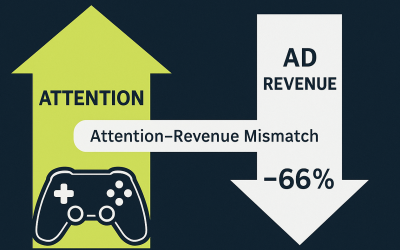Cross-Platform is King
Why Developers are Embracing H5’s Versatility for Monetization and Growth? In this post, I will try to highlight few of the trends we are seeing here in AppLixir and why Cross-Platform is the way to go (atleast, in our opionion)
As you may have read in various posts, the landscape of game and app development is shifting rapidly. Developers are no longer confined to creating products for a single platform. Users today expect seamless, cross-platform experiences, whether they’re on a mobile device, web browser, or desktop application. This shift is not only shaping the way games and apps are built, but also how they are monetized.
As developers expand from mobile apps to web platforms, and vice versa, HTML5 (H5) is proving to be a game-changer. Its versatility enables smooth development across multiple platforms, ensuring that users get a unified experience. In this blog, we’ll explore how cross-platform development is gaining traction, why H5 is at the center of this movement, and how monetization strategies like rewarded video ads are optimized for this future.
Contents
The Importance of Cross-Platform Development
-
Blurring Lines Between Platforms
The boundaries between mobile apps and websites are becoming increasingly blurred. Users switch from mobile to desktop with ease, expecting their content to flow seamlessly across devices. This trend has pushed developers to adopt cross-platform strategies that focus on delivering consistent experiences across the web, apps, and even gaming consoles.
A unified experience allows developers to maximize user engagement. Whether a user interacts with a product on a mobile app, web platform, or desktop, their experience should remain consistent. This expectation is pushing developers to design products that function well across platforms.
-
Developer Strategy: Start Cross-Platform
Cross-platform development is no longer an afterthought; it’s a core strategy from the outset. Developers who build their apps and games with a cross-platform mindset can launch faster, reach a wider audience, and offer better user experiences.
The most successful cross-platform developers use a unified codebase. This allows them to save time and resources, reducing the need to develop separate versions for different devices. Developers can deploy updates quickly and ensure that users across all platforms enjoy the same features.
-
Business Benefits of Cross-Platform Apps
Adopting a cross-platform approach offers developers significant business advantages. A key benefit is the ability to maximize potential revenue streams. Cross-platform apps inherently have a larger user base, as they can reach audiences across web, mobile, and desktop. This broader reach can translate to higher user engagement, app installs, and, ultimately, more opportunities for ad monetization.
For example, incorporating rewarded video ads into both web and mobile platforms allows developers to monetize users no matter where they interact with the game or app. With tools like AppLixir, rewarded video ads can be seamlessly integrated across all platforms, offering a unified ad experience that boosts user engagement and retention.
The Rise of HTML5 (H5) and Its Versatility
What is HTML5?
HTML5 (H5) is a robust markup language that has redefined the way developers build web and mobile applications. Its major advantage lies in its ability to provide a uniform experience across different platforms, including desktop browsers, mobile devices, and even Smart TVs. HTML5’s flexibility, lightweight performance, and wide compatibility make it an ideal choice for cross-platform development.
Advantages of HTML5 for Cross-Platform Development
HTML5 offers several advantages for developers:
- Easy Deployment: One of HTML5’s core strengths is its ease of deployment across platforms. Developers can use the same codebase for both web and mobile apps, minimizing the amount of work needed to maintain separate versions.
- Faster Load Times: Unlike traditional apps, which need to be downloaded and installed, HTML5 apps can be accessed instantly via a browser, ensuring faster load times and quicker updates.
- Seamless Updates: HTML5 apps allow for real-time updates without the need for users to download patches. This helps developers roll out bug fixes, new features, and improvements more efficiently.
- Less App Store Dependency: By bypassing app stores, developers can retain more control over their distribution and monetization strategies. This is especially important for developers using rewarded video ads or other in-app purchases, as they avoid app store commissions.
 Several developers have found success using HTML5 to expand their games and apps across platforms. One notable example is the rise of HTML5-based browser games. These games are developed once and can be played on both web browsers and mobile devices with little to no adjustments.
Several developers have found success using HTML5 to expand their games and apps across platforms. One notable example is the rise of HTML5-based browser games. These games are developed once and can be played on both web browsers and mobile devices with little to no adjustments.
For example, many popular games that started on mobile have transitioned into web-based versions using HTML5, leveraging the same codebase to provide a unified experience. Developers who adopt HTML5 can take advantage of this trend, bringing their mobile-first apps to a wider web audience and monetizing through cross-platform strategies like rewarded video ads.
Expanding from Apps to the Web (and Vice Versa)
Mobile-First to Web Expansion
The mobile-first approach is now extending to the web. Many developers initially build mobile apps and later transition them to web platforms, where they can capture a wider audience. With HTML5, this transition is relatively easy, as the same codebase can be leveraged for both platforms.
Web-to-Mobile: The Reverse Trend
Interestingly, we’re also seeing a reverse trend, where web-based applications are being transitioned into mobile apps. H5’s capabilities make it easy to port web applications to mobile, without sacrificing user experience or performance.
Unified Experience Across Platforms
Ultimately, users no longer care if they are using a mobile app or a web app—they want a unified experience. Developers must therefore embrace cross-platform development to keep users engaged, regardless of where they access the product. HTML5, with its versatility and flexibility, makes this possible.
Cross-Platform Monetization Strategies
Monetizing Across Devices
To monetize cross-platform apps effectively, developers need tools and strategies that work seamlessly across platforms. Rewarded video ads are one of the most popular and successful ways to monetize both web and mobile games.
AppLixir, for example, provides a simple solution for integrating rewarded video ads into games and apps across platforms. With AppLixir, developers can offer non-intrusive ads that provide value to users, encouraging them to watch short videos in exchange for in-game rewards.
HTML5 for Ad Revenue
HTML5’s versatility also extends to ad monetization. By using the same ad strategies across platforms, developers can simplify integration, improve user experience, and maximize revenue. Rewarded video ads, in particular, offer a strong opportunity to monetize across multiple platforms with minimal effort.
Developers can embed rewarded ads into both their web and mobile versions, ensuring a consistent experience for users and an easy-to-manage monetization strategy for themselves.
Future of Cross-Platform Development
Trends to Watch
The future of cross-platform development is bright. Developers should pay attention to trends such as WebGL for rendering 3D graphics, AR/VR applications, and Progressive Web Apps (PWAs). As these technologies evolve, cross-platform development will only become more powerful.
Developer Outlook
Many developers predict that the next phase of cross-platform development will focus on even more seamless user experiences, where the distinction between web and app completely disappears. Technologies like HTML5 and WebGL will continue to play a critical role in this transition.
Preparing for the Future
To future-proof their development strategies, developers should start building with HTML5 today. Cross-platform strategies and monetization tools like rewarded video ads will help ensure their products can scale across devices while providing strong revenue streams.
Cross-platform development is no longer optional—it’s the future. HTML5’s versatility is a key driver of this trend, enabling developers to build apps that run smoothly on both web and mobile platforms. Combined with strong monetization strategies, like rewarded video ads, developers can not only reach more users but also maximize revenue.
By adopting HTML5 and embracing cross-platform development, developers can stay ahead of the curve, deliver a consistent user experience, and ensure sustainable growth for their products.



